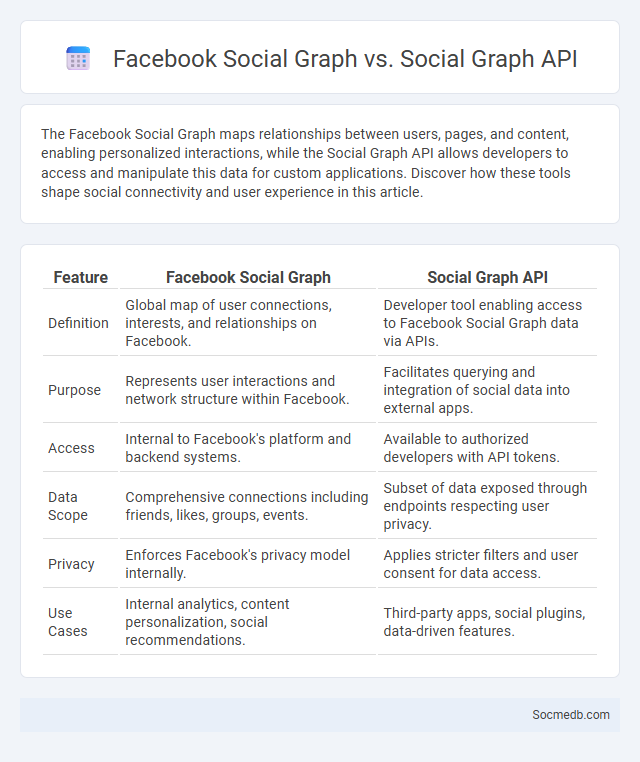
Photo illustration: Facebook Social Graph vs Social Graph API
The Facebook Social Graph maps relationships between users, pages, and content, enabling personalized interactions, while the Social Graph API allows developers to access and manipulate this data for custom applications. Discover how these tools shape social connectivity and user experience in this article.
Table of Comparison
| Feature | Facebook Social Graph | Social Graph API |
|---|---|---|
| Definition | Global map of user connections, interests, and relationships on Facebook. | Developer tool enabling access to Facebook Social Graph data via APIs. |
| Purpose | Represents user interactions and network structure within Facebook. | Facilitates querying and integration of social data into external apps. |
| Access | Internal to Facebook's platform and backend systems. | Available to authorized developers with API tokens. |
| Data Scope | Comprehensive connections including friends, likes, groups, events. | Subset of data exposed through endpoints respecting user privacy. |
| Privacy | Enforces Facebook's privacy model internally. | Applies stricter filters and user consent for data access. |
| Use Cases | Internal analytics, content personalization, social recommendations. | Third-party apps, social plugins, data-driven features. |
Introduction to Social Graph Concepts
The social graph represents the network of relationships and interactions among users on social media platforms, capturing connections such as friendships, followers, and group memberships. Understanding the social graph is crucial for analyzing user behavior, content dissemination, and influence patterns across networks like Facebook, Twitter, and LinkedIn. Leveraging social graph data enables targeted marketing, personalized recommendations, and enhanced user engagement strategies.
What is Facebook’s Social Graph?
Facebook's Social Graph represents the complex network of connections between users, pages, groups, and events on the platform. It maps the relationships and interactions, enabling personalized content delivery and targeted advertising. Understanding your position in this Social Graph helps tailor your online experience and enhances engagement with relevant connections.
How the Facebook Social Graph Functions
The Facebook Social Graph functions as a comprehensive map of relationships between users, pages, and content, enabling personalized experiences and targeted advertising. By analyzing connections such as friendships, likes, and shares, the platform leverages this interconnected data to optimize News Feed relevance and improve social interactions. You can benefit from this system by experiencing more meaningful content and enhanced social networking opportunities tailored to your interests.
Overview of Social Graph API
The Social Graph API enables developers to map and analyze connections between users, providing a structured representation of relationships and interactions across social networks. This API facilitates access to data such as friend lists, shared activities, and common interests, enhancing personalized user experiences and targeted content delivery. By integrating the Social Graph API, your applications can leverage social connectivity to improve engagement and deepen user insights.
Key Features of Social Graph API
The Social Graph API enables developers to access and analyze the connections among users, their relationships, and shared content across social networks. Key features include retrieving user profiles, mapping friend networks, and aggregating activity data to create personalized social experiences. By leveraging this API, Your applications can enhance user engagement through tailored recommendations and social insights.
Comparing Facebook Social Graph and Social Graph API
The Facebook Social Graph represents the complex network of connections between users, pages, and events on the platform, enabling rich visualization of relationships. The Social Graph API allows developers to access and manipulate this interconnected data programmatically, facilitating personalized user experiences and targeted content delivery. By leveraging the Social Graph API, You can unlock deeper insights into social interactions and enhance application functionality through dynamic relationship mapping.
The General Concept of Social Graph
The social graph represents the digital mapping of social relationships and interactions among users across social media platforms, visualizing connections such as friendships, followers, and shared content. Understanding the social graph allows you to analyze how information spreads, identify influential users, and optimize engagement strategies by leveraging network structures and behavior patterns. This concept serves as the backbone for personalized recommendations, targeted advertising, and social network growth.
Real-world Applications of Social Graphs
Social graphs map relationships and interactions among users, enabling personalized content delivery and targeted advertising on platforms like Facebook and LinkedIn. Your social graph data drives algorithms that recommend friends, groups, or products tailored to your interests. Companies leverage these connections for influencer marketing, community building, and enhancing user engagement metrics.
Privacy and Security in Social Graph Technologies
Social graph technologies collect vast amounts of personal data, making privacy and security critical concerns for your digital presence. Implementing robust encryption protocols and access controls helps protect sensitive information from unauthorized access and cyber threats. Ensuring transparency in data usage policies empowers you to maintain control over your social connections and personal information.
Future Trends in Social Graph Development
The future of social graph development centers on enhanced interoperability across platforms, enabling seamless data exchange and richer user interactions. Artificial intelligence and machine learning algorithms will increasingly analyze complex social connections to predict user behavior and customize content delivery. Privacy-preserving technologies such as decentralized identity management and blockchain integration will become essential in securing social graph data while maintaining user trust.
 socmedb.com
socmedb.com